Table of Contents
Blue Gourami Overview
The Blue Gourami (Trichogaster Trichopterus), also known as the Three Spot Gourami is a typical exotic fish from Southeast Asia and the northern island of Australia.
Despite how vibrant and delicate they look, these tiny creatures are one of the hardiest fishes in the tank. They evolve from the standard three-spot gourami and feature only two spots on their body, hence their classification.
If you consider adding a speck of bright blue color to your home tank, these are a perfect choice. They are not easily accessible, which reflects on their price. So, when buying them from the market, ensure that you check the authenticity and the ethics of the breeder.
This guide will discuss everything to know about blue gourami and the care they need in captivity.
| Information Chart | Blue Gourami |
| Scientific Name | Trichogaster trichopterus |
| Family | Gourami |
| Care Level | Easy to Intermediate |
| Temperament | Peaceful, Can show signs of aggression and territorial behavior |
| Color | Blue and white |
| Lifespan | Up to 5 years |
| Size | 5-6 inches |
| Diet | Omnivore |
| Minimum Tank Size | 30-35 gallons |
| Temperature | 72°F to 82°F |
| Water Conditions | Freshwater with slow current |
| Tank Mate Compatibility | Same species, similar size, peaceful |
Blue Gourami Appearance

A typical variation to the standard brown or lavender gourami, these blue ones feature a white-blue cross to their appearance. The standout feature of their anatomy is the presence of two spots. One is found in the center of the body and the other one around the base of the tail.
Blue Gourami shows a unique breathing system. It lives in poor waters in oxygen, swamps, and areas cultivated with rice and has developed a particular breathing system called the labyrinth. This is a highly vascularized organ made up of bone blades, which allow for the assimilation of atmospheric air and the gills.
This adaptation is a complex, oxygen-poor environment also resulted in a different reproduction behavior – the building of a bubble nest floating on the water’s surface to provide the oxygen needed for the eggs.
It is worth mentioning that Trichogaster trichopterus is very similar to Trichogaster leeri: the oval body, elongated and slightly flattened laterally. The anal fin starts from the gills and reaches the caudal peduncle.
The pectoral fins are filiform, thin, elongated, and are reduced to some “strands.” They are tactile organs that allow the fish to detect obstacles in water where visibility is low and find food; they also have an essential role in recognizing their partner or an enemy. The blue gourami can reach a body length of 15 cm in aquariums, the female being a little smaller. In nature, they can even get up to 20 cm.
One of the unique traits of this fish is its color. Although they have a bluish-white appearance, the fish changes color depending on their mood. The color tends to darken when they are in a chippy mood or during breeding. Also, they do have blue and white marbling all over their body.
Although they are known as the three-spot gourami, they have two visible spots on their body. The third spot is considered to be their eye. Also, if you find the other two spots losing color or fading, it is a sign that the fish is under metabolic stress.
Lifespan of Blue Gourami
The typical lifespan of a blue gourami fish is up to 5 years. The duration depends on the kind of care they are getting in the tank. If you are an aquarist that likes to build strong bonds with their fishes in the home aquarium, five years is a pretty long time to do so.

Although these fishes are pretty hardy, they are prone to risks of premature death. Some of the leading factors contributing to poor water quality, improper diet, and crowded tanks.
If you want to give them a comfortable life, it is a given that you need to be mindful of the above factors.
Blue Gourami Size
The typical blue gourami grows up to 5-6 inches in length. The female ones are a tad longer than the male ones. However, the difference is barely noticeable.
The size of these fishes depends on the tank conditions. If the conditions aren’t optimum, the same will reflect on their growth. So, if your fish doesn’t grow up to the standard 5-6 inches, chances are they aren’t comfortable in their surroundings.
Natural Habitat and Origin
Scientifically termed Trichogaster trichopterus, the blue gourami is a freshwater fish that readily adapts to any new environment they are kept in. Although they are predominantly found in South Asian countries, they are spread across the world in abundance.
These small fishes are found in vegetated areas, including the lowland marshes with cloudy and muddy freshwater streams.
Although they don’t require very close care, these fishes need special care to optimize their appearance. Any kind of stress can fade their color, making them lose their original attractive appearance.
Blue Gourami Care and Tank Set-up
Blue Gourami Tank Size and Specification
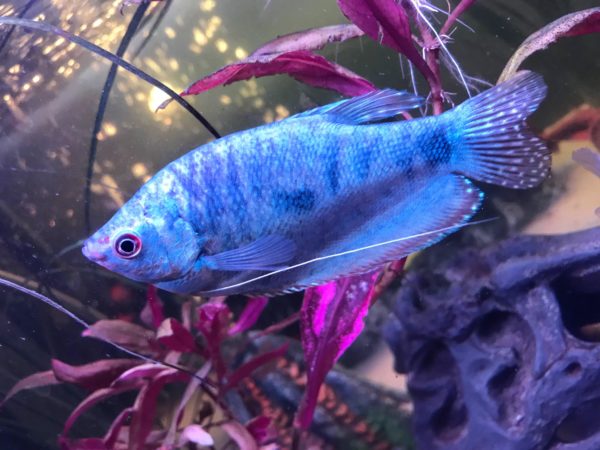
Keeping this fish often proves to be difficult due it having a territorial character. Most people tend to keep blue gourami in aquariums smaller than 100 liters, which is not recommended for the well-being of the fish. They require aquariums that are larger than 200 liters, where they can grow and develop well.
The height of the water column is less critical. What is to be considered is the length and width of the aquarium. It is recommended to have at least 1 meter long and width for a couple. The aquarium must have a lot of surface plants to mimic its natural habitat.
Optimum Tank Size for Blue Gourami
The recommended tank size for blue gourami is between 30-35 gallons, typically for adult fishes. For the juvenile ones, you can start with a smaller 20-gallon tank.
However, since these fishes are pretty territorial, you need to provide them with ample space to move around. If they don’t have enough space, it can lead to signs of aggression, including fin nipping.
Generally, a commercial aquarist will suggest keeping one blue gourami per tank. However, if required, you can double the tank size if you want to house more than one in a tank.
Filter Type
Blue gouramis tend to prefer water bodies with low currents. So, since they naturally stay in areas with less powerful water current in the wild, it is a given that you have to mimic the same in captivity too.
Although these gouramis aren’t heavy waste producers, they require a strong filter to keep the water clean. If you are housing multiple blue gouramis in a single tank, you need a strong filter. This clears out the excessive bioload from the tank, especially on their side.
The primary function of a strong filter is to clean the water and reduce the ammonia and nitrate levels in the tank.
Substrate
Sand or gravel serves as standard substrate choices. However, if you want these vibrant blue-colored gouramis to stand out from the rest, you need to focus on dark-colored substrates.
However, the substrate isn’t a necessity for these fishes because they aren’t bottom dwellers. You will often find the blue gourami around the surface of the tank.
Water Parameters for Blue Gourami
Although blue gouramis are hardy and can withstand water changes, we’d recommend maintaining their optimal water parameters. This gives the fishes a comfortable life without imposing risks of premature death.
The primary objective while taking care of blue gourami is to mimic the water conditions of their natural habitat. Here’s a quick breakdown that you should be mindful of:
Water temperature
The ideal water temperature for blue gourami is between 72°F to 82°F. Ideally, you should maintain the temperature at 76-degrees Fahrenheit for optimal growth and well-being.
pH level
The perfect pH level for blue gourami is between 6.0 to 8.0. The neutral pH of 7.0 is considered ideal. However, ensure that the water doesn’t include too many acidic or alkaline properties because that will put the fishes at stress risks.
Water hardness
The ideal water hardness level for blue gourami is between 4 to 18 dKH.
If you are keeping blue gouramis in your tank, we’d recommend being vigilant about the water conditions. Buy a tank thermometer and a water testing kit to check the pH and the water hardness. Any drastic change will put the fish under metabolic stress, so you want to avoid that.
Blue Gourami Tank Landscape
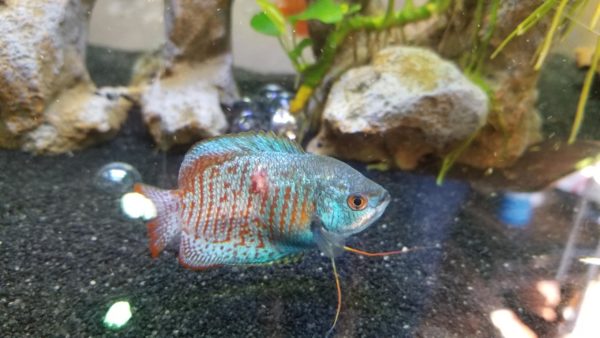
Besides the tank size and measurements and the water parameters, you must check the tank landscape. When decorating the tank for these vibrant blue fishes, you need to mimic their natural environments with sluggish backwaters and seasonal flooding.
While we have given an idea about the substrate and filter, there’s much more to know.
The first element of decoration in the tank is the live plants. So, spruce up the insides of the tank with some vegetation. However, whatever you add, make sure there’s enough space. If the tank is crowded, it will make it difficult for the fish to move around freely.
Freshwater aquarium plants like Ceratopteris provide shelter because the fish spends most of the time in the upper part of the aquarium. From a morphological point of view, this predisposition is visible through the mouth shape, oriented upward.
Along with plants, you can also add rocks and driftwood to mimic their natural habitat as in the wild. Although these fishes don’t typically rely on heavy oxygenation since they are surface dwellers, it’d be ideal for putting some air stones to keep the water well oxygenated either way.
Feeding Blue Gourami
The Blue gourami can eat almost anything from commercial fish food to artemia and grindal worms. They do require to be fed at least twice a week with vegetables (green lettuce or cucumber) because their digestive tract is more extended than other fish of the same size.
Besides the typical omnivore diet, blue gouramis also do well with the commercially available algae diet. We’d recommend using flakes over pellets. This is because they prefer staying on the surface instead of roaming down to the bottom.
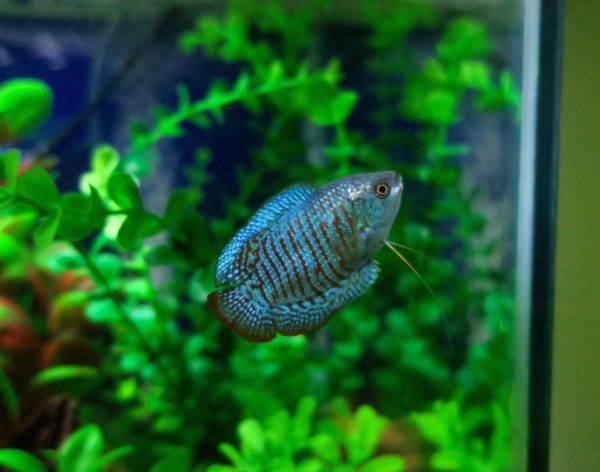
When feeding these blue gouramis, try to switch up the diet now and then. Giving them a variety of meal choices improves their nutrient intake and brightens up their color more.
Blue Gourami Behavior and Temperament
Although relatively peaceful, blue gouramis are highly territorial. If you place them in overcrowded tanks with similar species or other fishes, they will try to fight their way to dominance.
The male blue gouramis are comparatively more territorial and do get into fights now and then. The male ones even exert signs of aggression on the female fishes after breeding. So, it is crucial one removes them before things get out of hand.
Besides all these, the blue gouramis aren’t very hectic or troubling. Just ensure that you don’t put too many of the same kind in one tank or switch to a larger tank with lots of space.
Also, since they are surface dwellers, they will come up to the top of the tank to take in some air for easy breathing.
Blue Gourami Tank Mates
Blue gourami is an ideal fish for a community tank where it can coexist with other gourami fish if we provide enough space to delimitate their territories. The blue gourami does not appreciate larger fish or small and active ones such as Barbus tetrazona and Hypbessobrycon Callistus, which bite their fins.
Blue gouramis are sedentary fish. Once mature, they do not like the sudden changes in the aquarium environment. The same thing happens with the fry, which is quite fragile until they reach a length of about 5 cm.
However, given the territorial behavior that these small fishes showcase, you must find suitable tank mates. Ideally, you should choose tank mates of the same size and living conditions.
Pairing them with smaller fishes will result in the gouramis gobbling them up. At the same time, pairing them with larger fishes puts them under the stress of getting eaten.
Some of the ideal tank mates for blue gourami include:
- Clown Loach
- Catfish
- Tetras
- Platies
- Mollies
When choosing the tank mate for blue gourami, be cautious of all the factors. From size to the water parameters, you need to be mindful of every single pointer.
Breeding Blue Gourami
Sexual dysmorphism is easy to observe but less noticeable in young individuals. The male dorsal swimmer is more developed and sharp. The females are short and round. The female generally has less accentuated color, and the abdomen rounds as the ovarian mass develop, while the male remains slim.
Reproduction is relatively easy. An 80l aquarium is enough for spawning. The couple must be about one year old and have a body length between 7-9 cm.
Water quality is not very important, but it is preferable to have water that has not been filtered for a couple of weeks and has a lower hardness. The temperature will be between 25-28 °C. The aquarium must be covered to maintain a warm and humid atmosphere above the water. It is good to have the glass cover at a slight angle to avoid partial destruction of the nest due to drops that form during the condensation process. Filter and aeration of the aquarium are not mandatory, but a small external filter, set at minimum, will remove the bacterial pinnacle that forms on the water’s surface.
The aquarium must be well planted and have hideouts (flower pots, coconut shells, decorations from pet shops) for the female to use when overwhelmed by the male.
The male will start forming a bubble nest on the water’s surface, where the future eggs will be kept until hatching. This is just like betta fish. The breeding process consists of the male courting the female, seducing her, and bringing her under the bubble nest where they will start embracing. The female releases the eggs that the male will collect using its mouth and deposit them in the bubble nest.
The fry will hatch in about 36 hours, and they will stay in the bubble nest or attach to the aquarium wall. At the age of 3 days, they will begin to swim freely. It is recommended to remove the male from the aquarium because it may eat the young ones, though sometimes it simply ignores them, only eating the dead or sick ones.
The fry will grow fast if they have enough space, a rich and varied diet, and clean water, which we will renew about 10% every day. Make sure that you remove the female blue gourami from the breeding tank once they have laid the eggs.
Also, if possible, keep changing the water that the fry is growing in. This is because the first few weeks after birth is when the labyrinth organ forms, and having clean and well-oxygenated water during those weeks is crucial.
Blue Gourami Diseases and their Treatment
Like every other freshwater fish, even blue gouramis are at risk of developing or contracting diseases. The most common of them all is Ich, which is a parasitic infection.
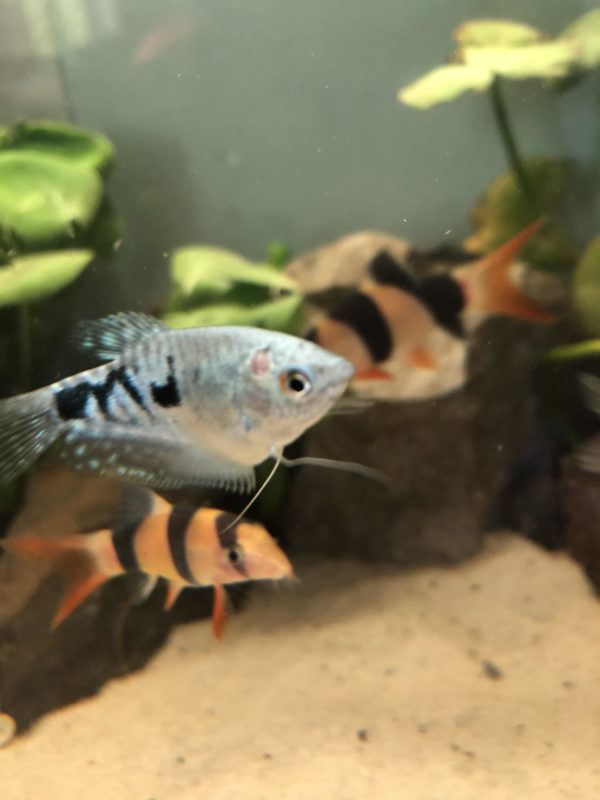
Although quite common, Ich is a brutal disease to treat and often results in the death of the fish. If you find the fish showing symptoms of Ich, it is ideal to remove them from the tank immediately since the disease is contagious.
Besides that, blue gourami fishes also suffer from skin issues, fungal infections, Velvet disease, to name a few.
Majority of the diseases that these fish contracts are preventable. All you need to do is maintain the ideal cleanliness in the tank. Keep the tank clean and filter the water every few weeks.
Another standard indicator of ill-blue gourami is a change in their color. If the fish depicts signs of fading or dull coloration on the body, it is a sign of illness. The most common issue is metabolic stress.
To avoid any of these issues, regulate the water parameters. Check the temperature, pH, and water hardness daily. Also, make sure that you change the water periodically to prevent prolonged health risks.
It doesn’t matter; if you notice anything amiss with the gourami, immediately take them out of the tank. Isolate and quarantine them in a separate tank and provide them with the treatment they need.
Are Blue Gouramis Right for You?
The choice of getting blue gourami for your fish tank is subjective. While some aquarists get the fish due to the vibrant color, some add them for their playful nature.
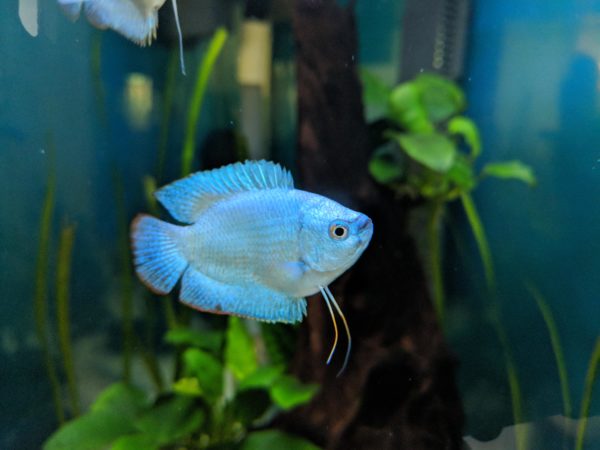
Whatever your reasons are, make sure they are in the best interests of the fish you are housing. If you aren’t ready to provide them with good living conditions, it is best to choose another species. We’d highly recommend you add one or two blue gouramis per tank if you are interested at all.
The maintenance and care aren’t as difficult, especially if you already have freshwater fishes in your home aquarium.
FAQs
How many blue gouramis can I put in a 10-gallon tank?
We’d recommend putting only one gourami in a 10-gallon tank. Since the area isn’t that large, you want to avoid overcrowding the tank with more fish because the male ones get territorial quickly.
Are Blue gouramis hardy?
Yes, blue gouramis are pretty hardy and can acclimatize themselves to change in water parameters. However, we’d recommend not exposing them to frequent changes because that puts them under metabolic stress.
Should Blue gouramis be kept in pairs?
If possible, try to keep the gouramis isolated in the tank (unless for breeding). Especially with male blue gouramis, you want to keep them separate to prevent fights and signs of aggression.
How to distinguish male and female blue gourami?
The distinguishing anatomical feature between the male, and female blue gourami is the dorsal fin. In female fishes, the dorsal fin is shorter and more rounded. While in males, the fin has a larger and elongated design.
Conclusion
If you are a novice with aquariums and freshwater fishes, you can still care for blue gouramis with the proper knowledge. They don’t require extreme commitment and effort, which makes them ideal for anyone to care for.
However, we understand that finding all the information under one roof can be difficult. So, we do hope this article gives you all the details that you are looking for. In case there’s anything else, leave a comment, and we’ll get back to you.
